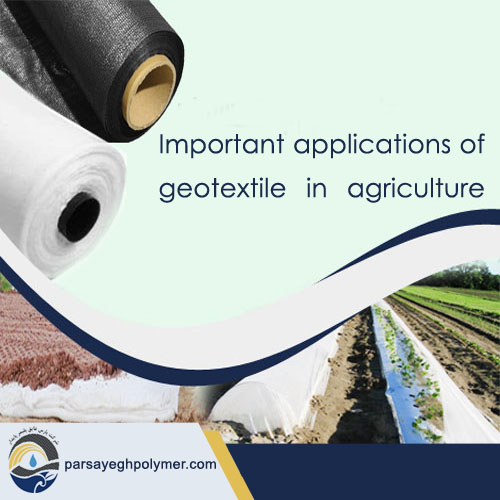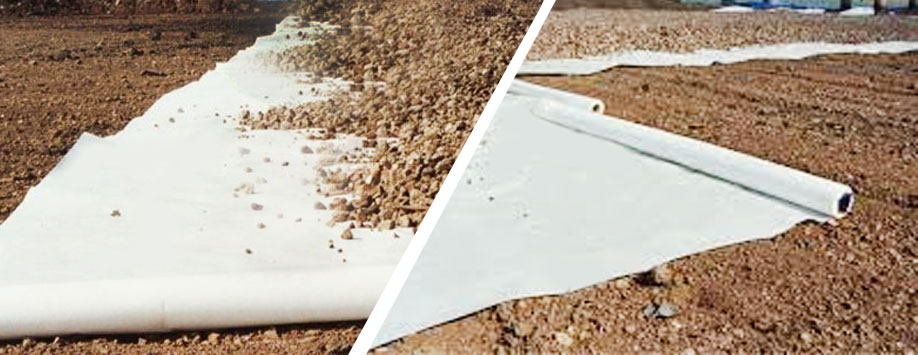Important applications of geotextile in agriculture

Geotextiles are increasingly used in agriculture due to their versatility, cost-effectiveness, and efficiency in addressing various soil and water management challenges. Here are the important applications of geotextiles in agriculture.
Soil erosion control with geotextile
Geotextiles are used to stabilize soil and prevent erosion in agricultural fields, especially on slopes, embankments, and around water bodies.
The geocomposites are one single products with a stable structure that prevent from wash out and allow vegetatation going through
They provide a protective layer that holds the soil in place, allowing vegetation to establish and roots to strengthen the soil structure.
Slopes are vulnerable to erosion due to water flow and weather conditions. Geotextile erosion control products provide a protective layer that minimizes erosion by evenly distributing water flow and reducing surface runoff. They help maintain the integrity of the slope and prevent the formation of gullies and rills.(1)
Drainage Improvement with geotextile
Geotextiles are used in drainage systems to facilitate the removal of excess water from fields.
They act as a filtration layer that allows water to pass through while preventing soil particles from clogging the drainage system, thereby maintaining effective drainage and reducing waterlogging.
Soil Separation with geotextile
Geotextiles are placed between different soil layers to prevent mixing and maintain soil structure in agricultural fields. They keep soil layers distinct, improving soil quality and preventing contamination of fertile topsoil with subsoil.
Woven geotextiles used for ground stabilization minimize rutting and prevent intermixing of the aggregate with the soft soils below. Think of woven geotextiles as affordable insurance for your aggregate. They save time and money by reducing or eliminating the need for additional rock.

Woven geotextiles are placed between the aggregate and the subgrade to stabilize the soil, preserve the aggregate and reinforce the surrounding soil. They will also keep mud below the rock from “pumping” up and help keep cleanup to a minimum.(2)
Soil Reinforcement with geotextile
Geotextiles are used to reinforce soil in areas with poor load-bearing capacity, such as in the construction of farm roads or retaining structures.
They enhance the strength and stability of the soil, allowing it to support heavy agricultural equipment and infrastructure.
Weed Control with geotextile
Geotextiles are used as a weed barrier in agricultural fields, gardens, and nurseries.Is used as an effective barrier for the control of weeds and roots. It is laid on the ground below the topsoil and its structure allows air, water and nutrients to pass through but prevents weed from emerging from dormant seeds below.
They block sunlight from reaching the soil surface, inhibiting weed growth while allowing air and water to permeate through to the plants.
Water Conservation
Geotextiles are used in water conservation systems, such as in the lining of canals, ponds, and irrigation ditches. Geotextiles reduce water loss through seepage, ensuring that water is directed efficiently to where it is needed in the fields.
Mulching
Geotextiles serve as a mulching layer in crop production.They help retain soil moisture, regulate soil temperature, and suppress weed growth, leading to better crop yields.
Filtration in Subsurface Irrigation
Geotextiles are used in subsurface irrigation systems to filter water before it reaches the plant roots. They prevent clogging of the irrigation pipes and emitters, ensuring a consistent water supply to the crops.
Fertilizer and Pesticide Containment
Geotextiles are used to contain fertilizers and pesticides in the root zone.They help minimize leaching and runoff, ensuring that these chemicals are efficiently used by plants and reducing environmental contamination.
Protection of Soil and Water Resources
Geotextiles are employed to protect soil and water resources in agriculture by preventing sediment and pollutant transport. They act as a barrier that filters and retains soil particles and pollutants, protecting waterways and improving water quality.
Summary
Geotextiles play a critical role in modern agriculture by addressing soil and water management challenges effectively. Their applications range from erosion control and drainage improvement to weed control and infrastructure development. The use of geotextiles helps enhance crop productivity, protect soil and water resources, and improve overall agricultural efficiency.
comments: 0 comment